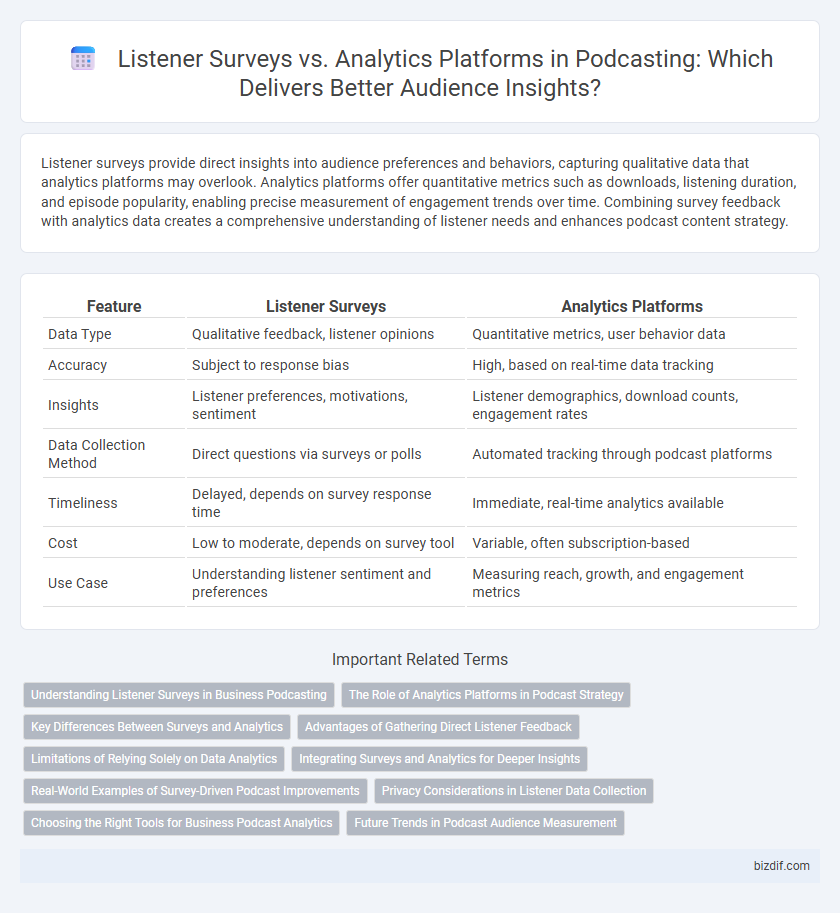Listener surveys provide direct insights into audience preferences and behaviors, capturing qualitative data that analytics platforms may overlook. Analytics platforms offer quantitative metrics such as downloads, listening duration, and episode popularity, enabling precise measurement of engagement trends over time. Combining survey feedback with analytics data creates a comprehensive understanding of listener needs and enhances podcast content strategy.
Table of Comparison
| Feature | Listener Surveys | Analytics Platforms |
|---|---|---|
| Data Type | Qualitative feedback, listener opinions | Quantitative metrics, user behavior data |
| Accuracy | Subject to response bias | High, based on real-time data tracking |
| Insights | Listener preferences, motivations, sentiment | Listener demographics, download counts, engagement rates |
| Data Collection Method | Direct questions via surveys or polls | Automated tracking through podcast platforms |
| Timeliness | Delayed, depends on survey response time | Immediate, real-time analytics available |
| Cost | Low to moderate, depends on survey tool | Variable, often subscription-based |
| Use Case | Understanding listener sentiment and preferences | Measuring reach, growth, and engagement metrics |
Understanding Listener Surveys in Business Podcasting
Listener surveys in business podcasting provide qualitative insights into audience preferences, motivations, and feedback that analytics platforms often miss. These surveys capture direct listener opinions on content relevance, episode topics, and overall satisfaction, enabling podcasters to tailor episodes for deeper engagement. Leveraging survey data alongside analytics enhances strategic decisions by combining quantitative metrics with nuanced listener experiences.
The Role of Analytics Platforms in Podcast Strategy
Analytics platforms provide podcasters with comprehensive data on listener demographics, engagement patterns, and episode performance, enabling data-driven decisions to refine content and marketing strategies. These platforms track real-time downloads, listening duration, and drop-off points, offering granular insights that listener surveys may miss. Leveraging analytics helps optimize release schedules, target audience segments, and enhance monetization opportunities in podcast strategy.
Key Differences Between Surveys and Analytics
Listener surveys provide qualitative insights by capturing direct feedback on audience preferences, motivations, and listening habits, while analytics platforms offer quantitative data such as download numbers, listener demographics, and episode performance metrics. Surveys reveal subjective listener experiences and engagement levels that raw analytics cannot discern, enabling podcasters to understand the why behind audience behavior. Analytics platforms deliver real-time, large-scale behavioral trends and patterns essential for measuring growth and refining marketing strategies.
Advantages of Gathering Direct Listener Feedback
Gathering direct listener feedback through surveys provides precise insights into audience preferences, motivations, and emotional connections, which analytics platforms cannot fully capture through data alone. Surveys enable podcasters to identify specific content improvements, listener demographics, and topics of interest, enhancing personalization and engagement. This qualitative data uncovers nuanced listener behavior and satisfaction, driving more targeted and effective content strategies.
Limitations of Relying Solely on Data Analytics
Relying solely on data analytics platforms in podcasting can lead to incomplete audience insights, as these tools often miss qualitative nuances like listener preferences and motivations. Listener surveys provide direct feedback that uncovers emotional connections and content satisfaction, which analytics metrics such as downloads and play duration cannot fully capture. Combining both methods offers a comprehensive understanding, enhancing content strategy and audience engagement beyond what analytics alone reveal.
Integrating Surveys and Analytics for Deeper Insights
Integrating listener surveys with analytics platforms enables podcasters to combine qualitative feedback with quantitative data for a comprehensive understanding of audience behavior. Surveys capture preferences, motivations, and satisfaction levels that analytics may overlook, while analytics provide real-time metrics like download numbers, listening duration, and geographic distribution. This combined approach enhances content strategy, advertising targeting, and audience engagement by aligning listener intent with measurable trends.
Real-World Examples of Survey-Driven Podcast Improvements
Listener surveys provide qualitative insights that analytics platforms often miss, such as audience preferences and detailed feedback on episode content. For example, the podcast "Science Vs" utilized listener surveys to identify topics that resonated most, leading to targeted episodes that increased engagement by 30%. Similarly, "The Minimalists" implemented survey-driven changes to their format, resulting in higher listener retention rates despite stable download numbers measured by analytics tools.
Privacy Considerations in Listener Data Collection
Listener surveys provide direct, consent-based data collection, ensuring compliance with privacy regulations like GDPR and CCPA by explicitly asking for user input. Analytics platforms gather behavioral insights passively but often rely on tracking technologies that may raise privacy concerns without transparent user consent. Balancing detailed audience understanding with strict adherence to data privacy standards is crucial for ethical podcasting practices.
Choosing the Right Tools for Business Podcast Analytics
Listener surveys provide qualitative insights into audience preferences and behaviors, capturing detailed feedback directly from podcast consumers. Analytics platforms offer quantitative data on download metrics, listener demographics, and engagement patterns, enabling data-driven decision-making for podcast growth. Combining listener surveys with analytics platforms creates a comprehensive understanding of podcast performance, helping businesses optimize content strategy and maximize audience reach.
Future Trends in Podcast Audience Measurement
Listener surveys provide qualitative insights into audience preferences and behaviors, while analytics platforms offer quantitative data on listenership patterns and engagement metrics. Emerging trends in podcast audience measurement emphasize integrating AI-driven analytics with real-time survey feedback to enhance audience profiling and content personalization. Future developments will likely involve advanced sentiment analysis and cross-platform data aggregation to deliver more accurate and actionable listener insights.
Listener Surveys vs Analytics Platforms Infographic

 bizdif.com
bizdif.com